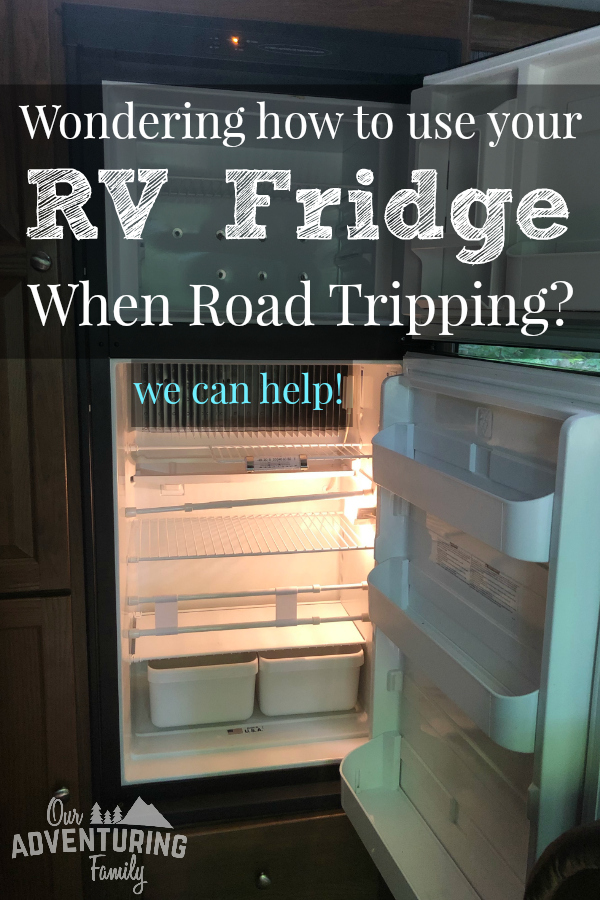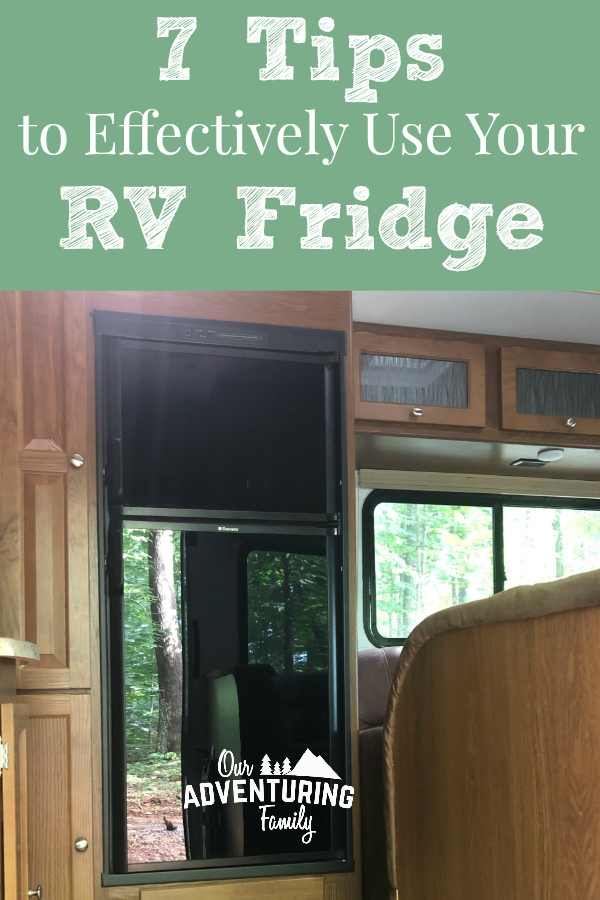This post may contain affiliate links. As an Amazon Associate I earn from qualifying purchases, but there is no additional cost for you. Please see my Disclosure page for more information.
When we bought our travel trailer a number of years ago, we weren’t sure how to get the fridge to work while we drove. We’d plug the trailer into an extension cord that was plugged into the house and let the fridge get cold 24 hours before we left, but once we unplugged and hit the road, it would start warming up. We tried putting 2-liter soda bottles with water frozen in them in the fridge, and that helped, but still wasn’t quite what we were looking for.
We eventually figured out that we if we left the propane on, the fridge power would stay on and it would stay cold.
But it’s not as simple as that
The problem with leaving the propane running while you drive is that it could cause a fire. Have you ever been stopped before going through a tunnel so they can check that your propane tank is shut off? They’re trying to minimize the chances of combustion occurring in the tunnel. Trailers and RVs do catch fire and whether it’s because of bad wiring or a propane issue can be hard to determine.
What your options are
Most RV and travel trailer fridges can be run off either propane or an electrical current. The electrical current needs to come through a shore power connection (plug into a power stanchion) or from an onboard generator.
For the fridge to be powered by propane, the propane needs to be on and the fridge needs to be fairly level. Some fridges also have the option to run off a 12-volt current (a three-way fridge), but most do not.
Our trailer didn’t have an onboard generator, so that wasn’t an option. The RV does, but we try to minimize our usage of the generator while driving because of the noise and fuel consumption. So we usually opt to keep the propane running to keep the fridge cold.
Decide on your comfort level
You’ll have to decide for yourself if you are comfortable having the propane on while driving. Like other aspects of RVing (or even just driving or living), there is risk involved, and you have to decide what risks are acceptable for you and your family.
If you do leave the propane on, be sure to turn it off before pumping gas and be prepared to stop and turn it off before entering certain longer tunnels.
If you’re not comfortable having the propane on, use the fridge as a cooler. Be sure to put in plenty of ice packs (those frozen 2-liters I mentioned earlier work well) to keep things cold, and open the door as infrequently as possible.

So you’ve figured out how you’ll keep your food cold, but what about what you’ll bring in the fridge?
1. First off, don’t overpack like we did on our first 5-week road trip
It was our very first time taking the trailer out, and we really didn’t know what to expect. I was so afraid of not being able to find gluten-free food along the way that I brought all the food I thought we’d need for the entire trip. We ate maybe half of that food and came home with a freezer still full of uneaten food.
It wasn’t a complete waste, but it was unnecessary. There will be grocery stores. They may carry different items from what you’re used to, but everybody eats, so there has to be a place to buy food. Even if you plan on boondocking away from civilization, you can stop at a grocery store near your destination and re-stock while you’re out adventuring.
2. Menu plan
RV fridges are usually smaller than residential fridges, so only bring food you’ll actually use and eat. There’s no room for that one special sauce that you only use in one recipe (unless you plan on making that recipe a lot). Simple meals with ingredients that can be used for more than one meal are a great way to go.
3. Plan ahead
These days, if you have food restrictions, it’s much easier to find allergen-friendly foods, even in basic stores like Wal-Mart. However, if there are certain foods you can only buy at certain stores like Costco, Whole Foods or your local natural foods store, you will need to plan ahead. Find those stores along your route, or go to the manufacturer’s site and use their item locator to see what other stores you might encounter on your route that carry that item. If you aren’t confident that you can find those foods along your route, and you must have them, buy extra and bring them with you. If possible, freeze them to save space in the fridge.
4. Be strategic when you load the fridge
Items will shift as you drive, so there is a bit of an art to loading the fridge in an RV.
We keep items like water bottles, butter, and condiments in the door. All those smaller items you don’t want rolling around when you open the door.
We keep sandwich stuff (lunch meat, cheese, etc) in one of the drawers. Sour cream and other odd-shaped containers in the other drawer, or sometimes fruit. I try not to put fruit in the drawers though since I’ve found that once it’s out of sight, it’s also out of mind and it may not get eaten.
We put a carton of eggs on the shorter top shelf with a single tension bar to keep them in place.
We put vegetables and fruit in a bowl or container so it’s easy to see. The container will protect them from the wire shelves and can be kept in place on the shelf with a double tension bar.
A jug of milk, meat that will be used very soon, and so on are stored on the lower shelf and everything else goes under and around the vegetables. Tension bars keep everything in place.
5. When will you be shopping next?
If we’re shopping more frequently, everything goes in the fridge that might remotely need it, because there is space available. When it will be longer between shopping trips, then we’re more picky about what goes in the fridge. ie, fruit and vegetables may have to sit on the counter and if something can be frozen, it’ll go in the freezer.
If it will be a while, and we have enough stuff that needs to be refrigerated and it won’t fit in the freezer, we’ll use the small cooler we bring with us. We bring it to keep our lunches cool while we’re out exploring during the day when camping, but it can serve other uses as well. We prefer not to use it long term as ice melts and get everywhere, but it will do in a pinch to keep refrigerated foods from spoiling.
6. Be sure to check the fit of the tension bars regularly
They loosen over time, they may have shifted position, or they may have been put back in place incorrectly.
7. Be sure the fridge and freezer are securely latched
Listen for that click! Otherwise, the door may swing open and food will tumble out as you drive down the road. Not that we’ve ever had that happen…. <cough, cough> I’m so glad it happened in the RV so I could hop up and shove everything back in quick. If it had happened in the trailer, we wouldn’t have known about it until our next stop.
Like a number of things when it comes to RVing, using the fridge isn’t complicated, it just takes a bit of time to get used to. Don’t be afraid to try different things to see what works for you and what doesn’t.
Have you found a different way of doing things that works for you? I’d love to hear about it!


Such a great post! The fridge is indispensable on road trips! We’ve found that vacation spots tend to have pricier grocery stores, so it’s great to be able to pack a lot of what we’ll need from home.
You would also benefit from a fridge fan. They run on batteries and will sit on one of your shelves. You can buy them in RV stores. The fan will circulate air throughout your fridge and keep everything colder. We have used one for a number of years and run on propane.
I am going to look into getting one of those fans. We camp on the water. It’s a cruising yacht. But the refrigerators are the pretty much the same. Small and you want to keep them cold. We have one up on deck and one below. I never know what I am working with…well, just bought a thermometer and next will be one of those fans. Thanks for the tip! Happy camping!
A thermometer is invaluable! That’s one thing I forgot to include in the post- using a thermometer to keep an eye on the internal temp. We have one in our fridge and it has definitely saved our bacon (and all the other food in the fridge) on more than one occasion when we realized the fridge was warming up instead of keeping everything cold. We’ve never used a fridge fan, but we’ll be getting one soon to see how much of a difference it makes.
Such a great idea! I’ve heard of them, but we’ve never used a fridge fan. I always figured it was a gimmicky thing that didn’t do much. Since it’s worked so well for you, I will definitely add it to my shopping list so we can try it out. Thanks for sharing!